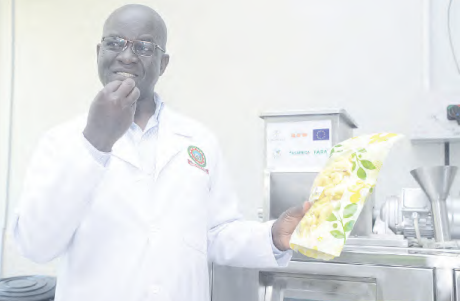
By Agatha Ngotho
Kenyans will soon have the opportunity to enjoy omena as a snack. If you’re not a fan of this delicacy, don’t worry, as you will still savour this highly nutritious food.
Known as silver cyprinid or dagaa in Swahili, omena has long been a staple in Nyanza. Recently, however, its popularity has surged as more Kenyans recognise its health benefits.
Lake Victoria is the largest freshwater lake in Africa and is home to a diverse fish population.
Prof Nelson Ojijo of the Department of Food Science and Technology at Jomo Kenyatta University of Agriculture and Technology said almost 40 per cent of the fish caught by fishermen in the lake is omena, and in terms of trade volume and consumption, omena is highly significant.
Omena is a nutritious source of high-quality protein, unsaturated fats and essential minerals like calcium. But despite its benefits, much of the omena catch is used for animal feed.
He attributed this to several factors, including a stigma associated with omena as “poor man’s food.” “Many people view omena negatively, associating it with low economic status,” he said.
Its metallic aftertaste and fishy odour deter many potential consumers. But this will soon change thanks to the Strengthening Agricultural Knowledge and Innovation Ecosystem for Inclusive Rural Transformation and Livelihoods in Eastern Africa project.
The project funded by the European Union at Sh35.6 million and supported by USAID with an additional Sh58 million is working to change this perception, and add value to omena and broaden its appeal.
Currently, most omena consumers come from communities around Lake Victoria, where it has been a traditional food.
“Our goal is to encourage Kenyans from other regions to appreciate the nutritional benefits of omena,” Ojijo said.
The project seeks to combat misconceptions about taste, appearance and social status. Researchers are developing products such as extruded cereal omena snacks, noodles and marinated omena. To create the snacks, they utilise an extruder—a high-temperature, short time processing machine that combines dried omena with a base like maize flour.
“The process involves drying omena, grinding it into powder, and mixing it with maize flour, water, and flavorings to mask the fishy aroma. We programme the extruder to dispense the right amount of ingredients,” he said.
Targeting the youth and children, the snacks will be sold at an affordable price. Feedback from recent showcases at the Nyeri Agricultural Society of Kenya show and Nairobi International Trade Fair has been overwhelmingly positive.
“We conducted test marketing to gather consumer feedback. Our aim is to eliminate the fishy aroma and make the snacks crunchy, allowing young people and children to enjoy the nutritional benefits,” he added.
The project also addresses significant post-harvest losses, particularly during the rainy season when fish catches peak. Margaret Mwanzia, a senior technologist at JKUAT, emphasised the importance of consumer feedback.
“We are working to improve the product based on feedback. We hope people will embrace it, as it is nutritious—high in protein, calcium and omega-3 fatty acids, which are beneficial for both children and adults,” she added.
Ojijo said omena is primarily marketed in its dry form, and the drying method used by many fishermen can lead to spoilage.
“When the sand (along the beaches) is unavailable during the rainy season, omena takes longer to dry, leading to high moisture content and spoilage, which can result in up to 50 per cent post-harvest loss,” he said.











